**Title: "The Remarkable Adaptations of Penguins: Masters of the Cold"** **Overview

The Remarkable Adaptations of Penguins: Masters of the Cold
Penguins are fascinating creatures that have adapted remarkably to their cold environments. Found primarily in the Southern Hemisphere, particularly in Antarctica, these flightless birds have evolved a variety of unique features that allow them to thrive in some of the harshest climates on Earth. In this post, we will explore the key adaptations of penguins that make them masters of the cold.
1. Insulating Feathers
Penguins have a dense layer of feathers that provide excellent insulation. Each feather is waterproof and traps air, creating a barrier against the cold. This unique feather structure helps maintain their body temperature, even in freezing waters.
2. Fat Reserves
Beneath their skin, penguins have a thick layer of blubber that serves as an energy reserve and additional insulation. This fat not only protects them from the cold but also provides energy during long periods of fasting, especially during breeding seasons.
3. Streamlined Bodies
Penguins possess a streamlined body shape that reduces drag while swimming. Their wings have evolved into flippers, allowing for agile and efficient movement underwater. This adaptation is crucial for hunting fish and other marine prey in icy waters.
4. Counter-Current Heat Exchange
To conserve body heat, penguins have a specialized circulatory system that utilizes counter-current heat exchange. This means that the blood vessels in their flippers and feet are arranged in such a way that warm blood flowing from the body warms the cooler blood returning from the extremities, minimizing heat loss.
5. Social Behavior
Penguins are highly social animals that often huddle together to conserve warmth. By clustering in large groups, they reduce exposure to the cold and create a microenvironment that helps maintain their body temperature.
6. Breeding Adaptations
Many penguin species have unique breeding adaptations that allow them to thrive in harsh conditions. For instance, Emperor penguins are known for their remarkable breeding strategy, where males incubate eggs on their feet under a flap of skin, keeping them warm during the frigid Antarctic winter.
Conclusion
Penguins are true masters of adaptation, showcasing a range of remarkable features that allow them to survive and thrive in some of the coldest environments on the planet. Their unique adaptations not only highlight the incredible power of evolution but also underscore the importance of conserving their habitats in the face of climate change. As we continue to study these remarkable birds, we gain valuable insights into resilience and survival in extreme conditions.
